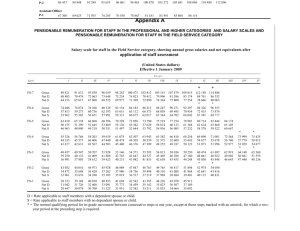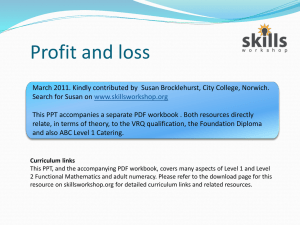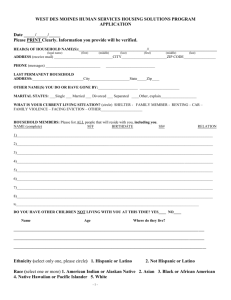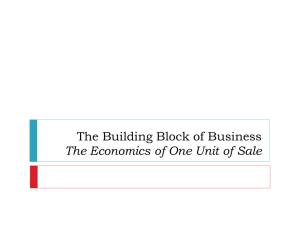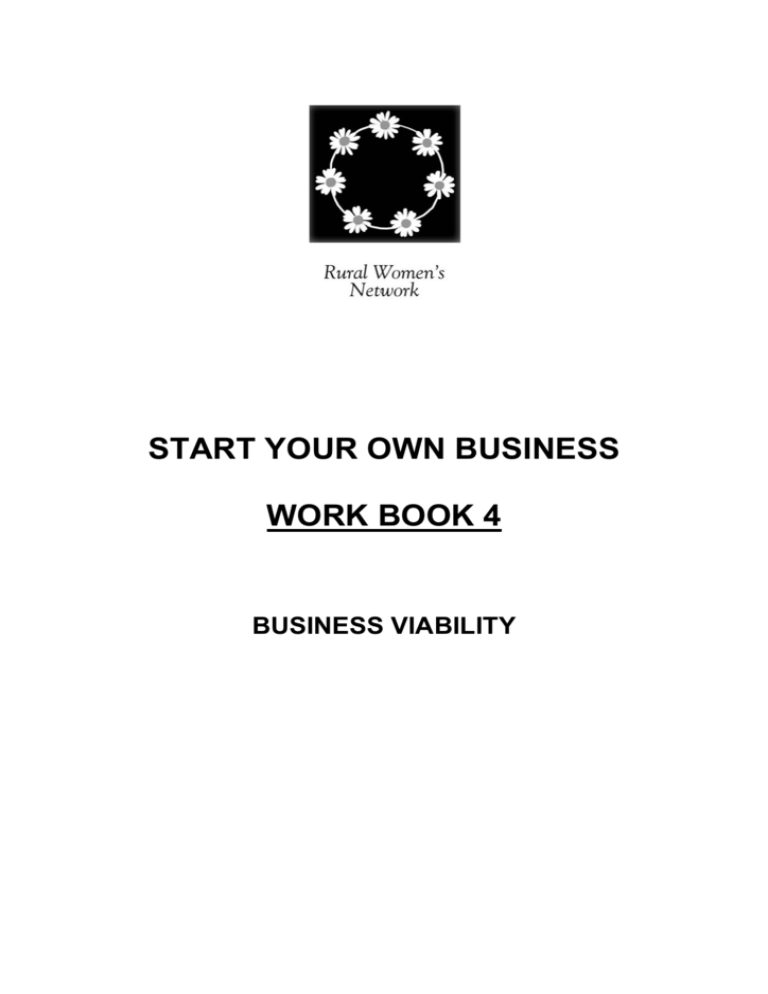
START YOUR OWN BUSINESS
WORK BOOK 4
BUSINESS VIABILITY
Work Book 4: Business Viability
•
•
•
•
BUSINESS VIABILITY
What costs do I need to consider – and what’s the difference between startup, fixed and variable costs?
How much do I need to sell to cover my costs and draw a living from the
business?
Is my business likely to be profitable in the future?
How much should I be charging for my product/service?
SETTING YOUR PRICE
Having looked at the idea of PRICE from a marketing perspective, it is also
necessary to consider price from a financial or costing perspective.
Some businesses make the mistake of looking at what price is being charged by
others and simply setting their price at the same value. After some time it becomes
apparent that the product or service is being provided at a loss and this puts the new
business venture in difficulties.
Below are some notes on how to cost your product or service. Firstly a distinction
between two different types of cost; Fixed and Variable.
UNDERSTANDING FIXED, VARIABLE & START UP COSTS
FIXED COSTS
The definition of a fixed cost is one which does not vary in total when the level of
output by the business does vary. In other words, when the Sales level within a
business increases, fixed costs in total, would not increase. It also follows that when
the Sales level in a business decreases, the fixed costs would not decrease.
An example of a fixed cost for a business making a product such as a bakery would
be the business rates. For a business producing a service such as massage therapy
would be any costs associated with the rent or ownership of premises, insurance,
and costs associated with the ownership of equipment.
As fixed costs are not dependent upon the level of output (sales), they are often
expressed as being per period of time, for example annually, weekly or monthly.
It can be helpful to picture costs in the form of a chart.
7
£,000
Fixed
Costs
6
5
4
3
2
Fixed costs
1
0
Level of output (sales) in 000’s loaves
© Copyright Voluntary Action Cumbria 2006 (all rights reserved)
14
2
Work Book 4: Business Viability
VARIABLE COSTS
Variable costs are those which DO vary as a total cost to the organisation when
output (number of items or services produced) varies. In fact a true variable cost will
vary in exactly the same proportion as the output.
In other words, as sales increase the variable costs increase.
An example of a variable cost for a bakery would be the cost of flour.
In a service business, there are often fewer variable costs. Often the main variable
cost in providing a service is the cost of wages for an employee working directly in
providing the service. Other variable costs in a service business would be anything
directly ‘used up’ during the provision of the service. For example with massage
therapy, oil may be used and there may be the cost of laundering one or two towels.
Variable costs should be able to be expressed per item of output or sales. If this
proves to be very difficult, you may need to classify such costs as fixed.
The chart below shows the total cost of flour for the bakery when its sales range
between 0 and 10000 loaves of bread assuming that the cost of flour is £1 per loaf.
£,000
total
variable
costs
of flour
Variable
costs
Output – Loaves of bread ‘000s
Some costs have both fixed and variable elements. These are semi variable costs.
If we added all the costs for a business together they would be likely to fall into this
pattern of behaviour shown in the chart below.
Total
costs
£,000
total
costs –
fixed and
variable
Output – Loaves of bread ‘000s
© Copyright Voluntary Action Cumbria 2006 (all rights reserved)
3
Work Book 4: Business Viability
WHAT ABOUT WAGES/LABOUR?
If you are employing someone, this is obviously a cost to the business. Whether it is
fixed or variable will depend on the nature of their terms of employment. Consider
the following scenarios;
Employee paid a basic wage for 37hours per week
Fixed or variable cost?
Employee paid a set amount per item produced (e.g. per therapy treatment or per
floral wreath)
Fixed or variable cost?
Employee paid for number of hours worked but no minimum hours guaranteed (e.g.
housekeeping staff paid to service holiday accommodation only when let)
Fixed or variable cost?
WHAT ABOUT YOUR OWN ‘WAGES’/LABOUR?
If you are a sole trader or trading as a partnership, your own earnings are not a cost,
they are a withdrawal from the profit, and are called ‘drawings’. However, when
looking at variable costs in order to price your product or service, you should include
a realistic figure for any direct labour involved to make sure that you are costing and
pricing your product realistically.
Your price to the customer must obviously be higher than the variable cost of
producing it!
Consider what would be the ‘going rate’ for direct labour in your business.
In determining your price to the customer, it is useful to include an element for direct
labour, however, when calculating break even, you need to consider your earning
needs separately.
Consider your own income needs from the business.
© Copyright Voluntary Action Cumbria 2006 (all rights reserved)
4
Work Book 4: Business Viability
USE THE SPACE BELOW TO IDENTIFY EXAMPLES OF FIXED COSTS FOR
YOUR OWN BUSINESS PROPOSAL – include £ quantities wherever possible.
COST ( e.g. Rent, Insurance)
£ per year
TOTAL
Own Income Needs
These, excluding your own income needs, can be included under ‘Projected Running
Costs’ on your Business Plan.
USE THE SPACE BELOW TO MAKE NOTES ABOUT YOUR VARIABLE COSTS
Direct Labour
THE NEXT STEP IS TO CALCULATE THE VARIABLE COSTS for your business.
© Copyright Voluntary Action Cumbria 2006 (all rights reserved)
5
Work Book 4: Business Viability
One of these Tables should help you to set out the costs for your product or service.
Some businesses produce either one single or a small number of products which are
fairly standard. In other words each product or service produced is not an individual
or customised item.
For example someone making 2 or 3 different types and sizes of loaf or carrying out
a standard half hour therapy treatment.
In this case you should be able to list the quantity and cost of each item being used
in production. This together with any costs of labour will give you the variable cost of
producing each item. You could still include a realistic cost of labour per hour at this
stage, even if it is work that you will be doing yourself.
Item
Qty used per item
£ per unit
Total £
Total
If you produce goods or services to order which are not standard and have already
produced some items, try the following method for a short period of time.
Step 1 - estimate the value of materials you had in stock before you started e.g.
Material and Thread for an upholsterer
Step 2 - add up all the amounts you have spent on materials during the period and
note how many hours have been spent in producing the good or services during the
period.
Step 3 – estimate the value of materials you have left in stock at the end of the
period.
Step 4 – insert the figures into the table below to calculate the cost of materials used
during the period.
Step 5 - Note down how many and what type of items have been produced during
the period.
£
Value of stock at start of period
Add Stock bought during period
Less Stock left at end of period
= Cost of materials for goods produced during period
Labour used on production during period
Total cost of goods produced during period
Remember to note the type and quantity of goods or
services produced during the period.
© Copyright Voluntary Action Cumbria 2006 (all rights reserved)
6
Work Book 4: Business Viability
If you have not yet produced any items, you could use the method above in the future
as you start producing, OR you could make some ‘prototype’ samples and keep
records of price and quantity of materials used.
Services also have fixed and variable costs, but often they do not involve the use of
materials or ingredients. Services still have variable costs but labour is likely to be a
much greater part of the cost.
It may be more useful to consider your service PER HOUR or per other standardised
unit such as SQUARE METERAGE. Your costing needs to relate to your charging
basis, so that if you intend to charge PER HOUR it would be most helpful to cost
PER HOUR.
The amount of the Variable Cost needs to be entered into ‘Setting Your Price’
Section under the column marked ‘Cost of Provision/Producing’ on the Business
Plan. In the case of non-standard products and/or services, you may need to
complete this table PER HOUR or PER UNIT (e.g. per sq m) as appropriate.
START UP COSTS
This term really relates to those expenses incurred prior to the business starting to
trade. Examples would be the initial stock, membership of a trade organisation,
purchase of a patent, company registration, or purchase of equipment needed to
start.
They are not really costs distinct from fixed or variable, but just expenses occurring in
Month 0 before trading starts in Month 1. They would be shown as such on a cash
flow forecast.
© Copyright Voluntary Action Cumbria 2006 (all rights reserved)
7
Work Book 4: Business Viability
UNDERSTANDING BREAK EVEN ANALYSIS
The difference between the Sales in a business and the variable costs is known as
the ‘Gross Profit’ (or the ‘Contribution to Fixed Cost ’). A simple example of gross
profit would be in a shop where the gross profit is the difference between the sales
price and the cost of an item.
A gross profit percentage is used to show this difference as a percentage of sales.
For example:
A shop has sales of £7,000 during a month. The cost of buying the goods for resale
is £2,450. This means that the gross profit is
£
Sales
Less variable costs
= Gross Profit
%
7,000
2,450
4,550
To calculate the gross profit as a percentage of sales, we use the formula
Gross profit £
Sales £
£4,550
£7,000
x 100
x 100 = 65%
The same calculation is used for a business making a product. For example
A chair maker sells a particular type of chair for £180. The variable costs of
producing that chair (timber, glue etc) is £54. What would be the gross profit and the
gross profit %?
£
%
Sales
Less variable costs
= Gross Profit
Gross profit £
Sales £
x 100
© Copyright Voluntary Action Cumbria 2006 (all rights reserved)
8
Work Book 4: Business Viability
Break even occurs when
Total Sales Income = Total Costs (both fixed and variable)
This means that neither a profit nor a loss has been made. This is useful in looking
at how realistic the possibility of covering the costs is – any sales above this figure
will start to provide a net profit.
Net profit (or loss) is what results when Fixed Costs are deducted from the Gross
Profit.
£
Sales
Less variable costs
= Gross Profit
Less fixed costs
= Net Profit
The method used to calculate the break even level of sales is as follows:
Step 1 - Note down an example of a sales figure or anticipated selling price (per hour
or per sq m or however you will price based on your knowledge of the market).
Step 2 - Note down the variable costs of producing that sales value (including any
employed direct labour, if truly variable, but excluding your own labour).
Step 3 – Calculate your GROSS PROFIT
£
Sales
Less Variable Costs
= Gross Profit
Step 4 – Calculate your GROSS PROFIT PERCENTAGE using the formula
Gross Profit £
Sales £
x 100
Step 5 – Calculate the break even level of sales using the formula below
Break Even Level of Sales =
Fixed Costs £ x 100
GP%
© Copyright Voluntary Action Cumbria 2006 (all rights reserved)
9
Work Book 4: Business Viability
EXAMPLE
A therapist offers many different treatments, and charges between £25 and £30 per
hour. She finds it difficult to estimate her variable costs per hour because each
treatment varies. However, she has managed to estimate from typical treatments
that when her sales are £600, her variable costs (for laundering towels, use of oils
and lotions and disposable items) are £60.
Following the steps below, calculate the break even level of sales if her fixed costs
(for rent, insurance and subscriptions) are £900 per year.
Step 1 - Note down sales figure
Step 2 - Note down the variable costs of producing that sales value
Step 3 – Calculate GROSS PROFIT
Sales
£
Less Variable Costs
£
= Gross Profit
£
Step 4 – Calculate GROSS PROFIT PERCENTAGE
Gross Profit £
Sales £
x 100
Step 5 – Calculate the break even level of sales using the formula below
Break Even Level of Sales =
Fixed Costs £ x 100
GP%
Use the table below to check out your calculation. The net profit should be zero.
£
Sales
Less variable costs
= Gross Profit
Less fixed costs
= Net Profit
Note that although only she only needs to turnover £1,000 per year to cover her
costs, this would not include any income for her.
© Copyright Voluntary Action Cumbria 2006 (all rights reserved)
10
Work Book 4: Business Viability
This information might also be useful to view on a chart. To draw a chart, you will
need to work out the total costs for two levels of output, say 0 output and £50,000.
The total cost lines and sales lines can then be plotted. The lines will cross at the
break even level of output.
The break even point should be the same as on your calculation.
Example of Break Even Chart
Sales revenue
£,000
Total
Total costs (fixed
And variable)
Break even
Output – Sales in ‘000s
Supposing the therapist needs an income of £18,000 to replace her existing job, we
can calculate the amount of sales needed to provide this level of income (net profit)
by adding her income needs to the fixed costs. The formula in Step 5 would be
amended to
Level of Sales to provide income needs =
Fixed Costs £ + Income Needs x 100
GP%
Check your calculations by completing the table below:
£
Sales
Less variable costs
= Gross Profit
Less fixed costs
= Net Profit
© Copyright Voluntary Action Cumbria 2006 (all rights reserved)
11
Work Book 4: Business Viability
EXERCISE
An upholsterer carries out customised work. She estimates each job based
on the cost of materials to complete the work. To find the amount to be
charged out to the customer, she multiplies the amount it costs by 2.5 (two
and a half). So that when her material costs are £100, her sales price to the
customer is £250.
The upholsterer’s fixed costs are £1,800 per year. Calculate the level of sales
turnover needed for her to break even.
Step 1 - Note down sales figure
Step 2 - Note down the variable costs of producing that sales value
Step 3 – Calculate GROSS PROFIT
Sales
£
Less Variable Costs
£
= Gross Profit
£
Step 4 – Calculate GROSS PROFIT PERCENTAGE
Gross Profit £
Sales £
x 100
Step 5 – Calculate the break even level of sales using the formula below
Break Even Level of Sales =
Fixed Costs £ x 100
GP%
Check your calculations by completing the table below:
£
Sales
Less variable costs
= Gross Profit
Less fixed costs
= Net Profit
What level of turnover would be needed to provide a profit of £6,000?
Level of Sales to provide income needs =
Fixed Costs £ + Income Needs x 100
GP%
Check your calculations by completing the table below:
£
Sales
Less variable costs
= Gross Profit
Less fixed costs
= Net Profit
© Copyright Voluntary Action Cumbria 2006 (all rights reserved)
12
Work Book 4: Business Viability
EXERCISE
A Bakery has the following costs for a loaf of bread. Flour £0.20, yeast £0.05, butter
£0.05, oven power £0.10. The bakery needs to pay £2,000 per year for rates, £3,000
per year for rent and £1,000 per year for depreciation. If the price of a loaf of bread
is £1.60, calculate the sales figure needed to break even.
Step 1 - Note down sales figure
Step 2 - Note down the variable costs of producing that sales value
Step 3 – Calculate GROSS PROFIT
Sales
£
Less Variable Costs
£
= Gross Profit
£
Step 4 – Calculate GROSS PROFIT PERCENTAGE
Gross Profit £
Sales £
x 100
Step 5 – Calculate the break even level of sales using the formula below
Break Even Level of Sales =
Fixed Costs £ x 100
GP%
Then use the table below to check out your calculation. The profit/loss figure should
be zero.
£
Sales
Less variable costs
= Gross Profit
Less fixed costs
= Net Profit
What would the turnover need to be to provide a net profit of £30,000?
Level of Sales to provide income needs =
Fixed Costs £ + Income Needs x 100
GP%
£
Sales
Less variable costs
= Gross Profit
Less fixed costs
= Net Profit
© Copyright Voluntary Action Cumbria 2006 (all rights reserved)
13
Work Book 4: Business Viability
SUMMARISING BREAK EVEN ANALYSIS
Break even is the level of sales income at which;
Sales income = Total costs (both fixed and variable)
There is a 5 step method to gather information and then to calculate this.
Break Even Level of Sales =
Fixed Costs £ x 100
GP%
This can be adapted to calculate level of turnover required to provide a specific
amount of profit by adding that figure to the fixed costs.
Level of Sales to provide income needs =
Fixed Costs £ + Income Needs x 100
GP%
YOUR BUSINESS
When you have your variable and fixed costs figures you can insert these figures into
your formula to calculate your break even below.
Break even analysis should give you a tool allowing you to experiment with different
prices and costs.
Try increasing and decreasing the price of your product or service. How does this
affect your break even?
How does your projected break even point compare with your anticipated sales
level? When will you start to ‘break-even’?
BUSINESS VIABILITY & COSTS
Recall the example worked for the upholsterer’s business. This business had fixed
costs of £1800 per year. The variable costs were 40% of sales, giving a gross profit
of 60%. We used the formula to calculate the level of sales needed to break even.
Break Even Level = Total Fixed Costs
GP%
x100
=
£1,800
60
x
100
Supposing the entrepreneur planning to run this business had a family member who
owned a large successful interior design shop. They offer the entrepreneur a NEW
DEAL whereby they can use a small area of the shop for a rent of £180 per year but
will want 54% commission on any sales.
This means that fixed costs have now reduced to £180, but variable costs are 94% of
sales (i.e. 40% materials and 54% commission) meaning that Gross Profit is only 6%
of sales.
Recalculate the break even level of output under the new deal.
Break Even Level = Total Fixed Costs
GP%
x100
=
© Copyright Voluntary Action Cumbria 2006 (all rights reserved)
14
Work Book 4: Business Viability
These figures have been set deliberately to give the same break even level, but if we
look at different levels of output, either side of the break even, there are differences
in the performance of the business.
These are best shown on the chart below:
BREAK EVEN CHART COMPARING
‘OLD DEAL’ & ‘NEW DEAL’
Sales revenue
Total Costs (f & v)
NEW DEAL
£ Cost
&
Sales
Total costs (fixed
and variable)
OLD DEAL
Break even
Output – Sales £
What conclusions can we draw from this, and how would this impact on a ‘fledgling’
business?
Lower fixed costs means ………………………. LOSS when operating BELOW break
even level but
…………………………… PROFIT when operating ABOVE break even
© Copyright Voluntary Action Cumbria 2006 (all rights reserved)
15
Work Book 4: Business Viability
GLOSSARY OF TERMS
These terms help to develop an understanding of some of the terminology used
when talking about money and business.
Fixed Assets
Items of significant cost purchased for use by the business in the course of trade
which are expected to be used for more than current accounting period. For
example, equipment and vehicles. This would exclude items bought for resale e.g.
Stock.
Depreciation
The cost of owning a fixed asset apportioned over the period of ownership.
Drawings
Amounts withdrawn from the business by the owner(s) for personal use. This would
include private expenses e.g. credit card bill, regular weekly cash, proportions of
expenses for private use e.g. 50% motoring costs, payments to Inland Revenue for
Tax and NIC.
Gross Profit
The difference between Sales and Cost of Goods Sold as a percentage of Sales
Mark Up
The difference between Sales and Cost of Goods Sold as a percentage of Cost
MARK UP & GROSS PROFIT
A 100% mark up gives 50% gross profit
Net Profit
Gross Profit less (fixed) business expenses
£
Sales
Less variable costs
= Gross Profit
Less fixed costs
= Net Profit
© Copyright Voluntary Action Cumbria 2006 (all rights reserved)
16




